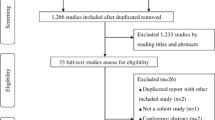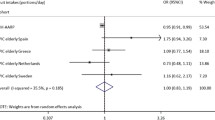Abstract
Purpose
Fruit and vegetable intake has been inversely associated with the risk of hypertension; however, there is inconsistent evidence on the long-term association. Given this gap in the literature, it is necessary to identify evidence from large prospective studies, especially in China, where insufficient evidence exists. Thus, we examined the association of fruit and vegetable intake with incident hypertension in Chinese adults.
Methods
We conducted analyses among 5659 Chinese adults aged 18–64 years, free of cardiovascular disease, cancer, and hypertension in the 2006 wave of the China Health and Nutrition Survey. Fruit and vegetable intake was assessed using consecutive 24-h recalls. Incident hypertension was identified from the 2011 wave of the survey.
Results
A total of 866 participants developed incident hypertension. The relative risks (RRs) and 95% confidence intervals (CIs) of hypertension were 0.74 (0.55–0.99), 0.65 (0.48–0.88), 0.68 (0.50–0.92), and 0.73 (0.53–0.99) comparing each quintile group of fruit and vegetable intake with the lowest quintile group. These associations attenuated for the change of intake but remained significant for the fourth quintile, of which the RR (95% CI) was 0.65 (0.47–0.89). The magnitude of association was stronger among those who were younger, female, overweight and had prehypertension. When examined separately, fruit intake was more strongly and significantly associated with lowering BP than vegetable intake. Adding body mass index to the models attenuated all associations.
Conclusions
Greater long-term intake and increased intake of fruit and vegetables may reduce the risk of developing hypertension in Chinese adults.
Similar content being viewed by others
References
Lim SS, Vos T, Flaxman AD et al (2013) A comparative risk assessment of burden of disease and injury attributable to 67 risk factors and risk factor clusters in 21 regions, 1990–2010: a systematic analysis for the Global Burden of Disease Study 2010. Lancet 380:2224–2260
Patricia MK, Megan W, Kristi R et al (2005) Global burden of hypertension–analysis of worldwide data. Lancet 365:217–223. https://doi.org/10.1016/S0140-6736(05)17741-1
Wang J, Zhang L, Wang F et al (2014) Prevalence, awareness, treatment, and control of hypertension in China: results from a national survey. Am J Hypertens 27:1355–1361. https://doi.org/10.1093/ajh/hpu053
Huang K, Song YT, He YH, Feng XL (2016) Health system strengthening and hypertension management in China. Glob Health Res Policy 1:13. https://doi.org/10.1186/s41256-016-0013-8
Chen WW, Gao RL, Liu LS et al (2017) China cardiovascular diseases report 2015: a summary. J Geriatr Cardiol 14:1–10. https://doi.org/10.11909/j.issn.1671-5411.2017.01.012
Liu J, Miao J, Zhang D (2016) Dilemma of healthcare reform and invention of new discipline of health fiscalogy. Glob Health Res Policy 1:4
Appel LJ, Brands MW, Daniels SR et al (2006) Dietary approaches to prevent and treat hypertension: a scientific statement from the American Heart Association. Hypertension 47:296–308. https://doi.org/10.1161/01.HYP.0000202568.01167.B6
Sacks FM, Moore TJ, Appel LJ et al (1999) A dietary approach to prevent hypertension: a review of the Dietary Approaches to Stop Hypertension (DASH) Study. Clin Cardiol 22:6–10
John JH, Ziebland S, Yudkin P et al (2002) Effects of fruit and vegetable consumption on plasma antioxidant concentrations and blood pressure: a randomised controlled trial. Lancet 359:1969–1974. https://doi.org/10.1016/S0140-6736(02)98858-6
Li B, Li F, Wang L, Zhang D (2016) Fruit and vegetables consumption and risk of hypertension: a meta-analysis. J Clin Hypertens 18:468–476
Wu L, Sun D, He Y (2016) Fruit and vegetables consumption and incident hypertension: dose–response meta-analysis of prospective cohort studies. J Hum Hypertens 30:573–580
Nuñez-Cordoba JM, Alonso A, Beunza JJ et al (2009) Role of vegetables and fruits in Mediterranean diets to prevent hypertension. Eur J Clin Nutr 63:605–612. https://doi.org/10.1038/ejcn.2008.22
Wang L, Manson JE, Gaziano JM et al (2012) Fruit and vegetable intake and the risk of hypertension in middle-aged and older women. Am J Hypertens 25:180–189. https://doi.org/10.1038/ajh.2011.186
Fan AZ, Mallawaarachchi DSV, Gilbertz D et al (2010) Lifestyle behaviors and receipt of preventive health care services among hypertensive Americans aged 45 years or older in 2007. Prev Med (Baltim) 50:138–142
de Ramirez SS, Enquobahrie DA, Nyadzi G et al (2010) Prevalence and correlates of hypertension: a cross-sectional study among rural populations in sub-Saharan Africa. J Hum Hypertens 24:786–795. https://doi.org/10.1038/jhh.2010.14
Lin LP, Liu CT, Liou SW et al (2012) High blood pressure in adults with disabilities: influence of gender, body weight and health behaviors. Res Dev Disabil 33:1508–1515. https://doi.org/10.1016/j.ridd.2012.03.027
Chen Y, Lü J, Li LM et al (2010) Effects of diet and physical activity factors on blood pressure in nine provinces of China: a longitudinal analysis. Zhonghua Liu Xing Bing Xue Za Zhi 31:500–505
Xiao Y, Su C, Ouyang Y, Zhang B (2015) Trends of vegetables and fruits consumption among Chinese adults aged 18 to 44 years old from 1991 to 2011. Zhonghua Liu Xing Bing Xue Za Zhi 36:232–236
Popkin BM, Du S, Zhai F, Zhang B (2010) Cohort Profile: The China Health and Nutrition Survey—monitoring and understanding socio-economic and health change in China, 1989–2011. Int J Epidemiol 39:1435–1440
Batis C, Sotres-Alvarez D, Gordon-Larsen P et al (2014) Longitudinal analysis of dietary patterns in Chinese adults from 1991 to 2009. Br J Nutr 111:1441–1451. https://doi.org/10.1017/S0007114513003917
Popkin BM, Lu B, Zhai F (2002) Understanding the nutrition transition: measuring rapid dietary changes in transitional countries. Public Health Nutr 5:947–953. https://doi.org/10.1079/PHN2002370
Ainsworth BE, Haskell WL, Herrmann SD et al (2011) 2011 Compendium of physical activities: a second update of codes and MET values. Med Sci Sports Exerc. https://doi.org/10.1249/MSS.0b013e31821ece12
Ng SW, Norton EC, Popkin BM (2009) Why have physical activity levels declined among Chinese adults? Findings from the 1991–2006 China health and nutrition surveys. Soc Sci Med 68:1305–1314. https://doi.org/10.1016/j.socscimed.2009.01.035
Cawley J (2004) An economic framework for understanding physical activity and eating behaviors. Am J Prev Med 27:117–125. https://doi.org/10.1016/j.amepre.2004.06.012
Borgi L, Muraki I, Satija A et al (2016) Fruit and vegetable consumption and the incidence of hypertension in three prospective cohort studies. Hypertension 67:288–293. https://doi.org/10.1161/HYPERTENSIONAHA.115.06497
Camões M, Oliveira A, Pereira M et al (2010) Role of physical activity and diet in incidence of hypertension: a population-based study in Portuguese adults. Eur J Clin Nutr 64:1441–1449. https://doi.org/10.1038/ejcn.2010.170
Savica V, Bellinghieri G, Kopple JD (2010) The effect of nutrition on blood pressure. Annu Rev Nutr 30:365–401. https://doi.org/10.1146/annurev-nutr-010510-103954
Aburto NJ, Hanson S, Gutierrez H et al (2013) Effect of increased potassium intake on cardiovascular risk factors and disease: systematic review and meta-analyses. BMJ 346:f1378. https://doi.org/10.1136/bmj.f1378
Whelton PK, Klag MJ (1989) Magnesium and blood pressure: review of the epidemiologic and clinical trial experience. Am J Cardiol 63:26G–30G
Juraschek SP, Guallar E, Appel LJ, Iii ERM (2012) Effects of vitamin C supplementation on blood pressure: a meta-analysis of randomized controlled trials. Am J Clin Nutr 4:1079–1088. https://doi.org/10.3945/ajcn.111.027995.INTRODUCTION
Tamai Y, Wada K, Tsuji M et al (2011) Dietary intake of vitamin B12 and folic acid is associated with lower blood pressure in Japanese preschool children. Am J Hypertens 24:1215–1221. https://doi.org/10.1038/ajh.2011.133
Toh JY, Tan VMH, Lim PCY et al (2013) Flavonoids from fruit and vegetables: a focus on cardiovascular risk factors. Curr Atheroscler Rep 15:368. https://doi.org/10.1007/s11883-013-0368-y
Steffen LM, Kroenke CH, Yu X et al (2005) Associations of plant food, dairy product, and meat intakes with 15-y incidence of elevated blood pressure in young black and white adults: the Coronary Artery Risk Development in Young Adults (CARDIA) Study. Am J Clin Nutr 82:1169–1177
Tsubota-Utsugi M, Ohkubo T, Kikuya M et al (2011) High fruit intake is associated with a lower risk of future hypertension determined by home blood pressure measurement: the OHASAMA study. J Hum Hypertens 25:164–171
Song HJ, Paek YJ, Choi MK, Lee HJ (2014) Gender differences in the relationship between risk of hypertension and fruit intake. Prev Med (Baltim) 67:154–159. https://doi.org/10.1016/j.ypmed.2014.07.016
Acknowledgements
This research uses data from the China Health and Nutrition Survey (CHNS). We thank the China National Institute of Nutrition and Food Safety; the China Center for Disease Control; the National Institutes of Health [Grant numbers R01HD30880, P30DK056350, R21DK089306, R01HL108427, and R01HD38700]; the Fogarty International Center of the National Institutes of Health; the China–Japan Friendship Hospital; and the Chinese Ministry of Health.
Author information
Authors and Affiliations
Corresponding author
Ethics declarations
Conflict of interest
The authors declare that they have no conflicts of interest.
Rights and permissions
About this article
Cite this article
Liu, Mw., Yu, Hj., Yuan, S. et al. Association between fruit and vegetable intake and the risk of hypertension among Chinese adults: a longitudinal study. Eur J Nutr 57, 2639–2647 (2018). https://doi.org/10.1007/s00394-018-1687-0
Received:
Accepted:
Published:
Issue Date:
DOI: https://doi.org/10.1007/s00394-018-1687-0




